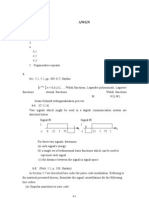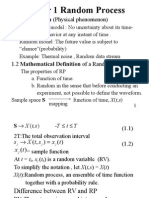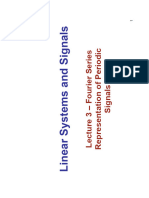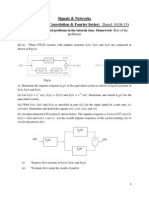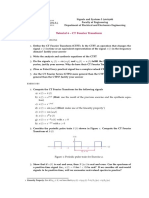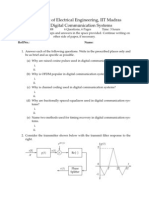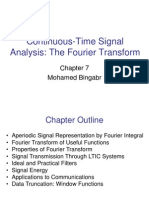Professional Documents
Culture Documents
It 2cos (2) ) TRT) ,: E-Stu (T)
It 2cos (2) ) TRT) ,: E-Stu (T)
Uploaded by
Naeem GulOriginal Description:
Original Title
Copyright
Available Formats
Share this document
Did you find this document useful?
Is this content inappropriate?
Report this DocumentCopyright:
Available Formats
It 2cos (2) ) TRT) ,: E-Stu (T)
It 2cos (2) ) TRT) ,: E-Stu (T)
Uploaded by
Naeem GulCopyright:
Available Formats
ltr A-tVl, May I, ZUlg
1. (20pts) Consider the continuous-time cascaded system below.
h(t)
h(t)
If the impulse response of each system is:
h1(t) :su(t), hz(t) : e-stu(t), fu(t) : d(t - 2).
what is the impuise response h(t) of the cascaded (entire) system?
2' (20pts) In the generation of communication signals, often two signals are
multiplied. It is
called modulation. Let
g1(t) : 2cos(2}}trt), gz(t): 5 cos(10002r.t)
and the modulated signal
% (t) :
s{t) sz(t) : 10 cos (200r'l) cos ( 1000zrr).
Using Fourier transform) we can find that the signal g3(r) is the sum of two sine and/or
cosine
signals with different frequencies. Express gs(t) to show these two frequencies.
3' (20pts) The continuous-time signal z(t) ls to be sampled. If the signal is filtered
to 4kHz
bandwidth, what is the minimum sampling rate do you need to choose in order to avoid
aliasing?
What is the maximum sampling period?
. (20pts) Consider the periodic signal r[n] shown below.
_3_2_1012345n
Calculate the discret-time Fourier transform of rfnl.
5' (20pts) Determine the causali'ty and stabtlity of the LTI system with the
following impuise
response.
h(t) : d(r - 1) + etu(-t - t).
You might also like
- Zero and First Order HoldDocument6 pagesZero and First Order Holdnirmal_inboxNo ratings yet
- Final Exam: EECE 3410 Spring 2020 NameDocument3 pagesFinal Exam: EECE 3410 Spring 2020 NameNaeem GulNo ratings yet
- Assignment 6Document2 pagesAssignment 6altoprimeNo ratings yet
- Ect204 Signals and Systems, June 2022Document4 pagesEct204 Signals and Systems, June 2022instapc0210No ratings yet
- Unit-IV-Pulse Modulation & Digital Modulation Modulation: StaffDocument15 pagesUnit-IV-Pulse Modulation & Digital Modulation Modulation: StaffGokul SaharNo ratings yet
- University of Manchester CS3291: Digital Signal Processing '05-'06 Section 7: Sampling & ReconstructionDocument12 pagesUniversity of Manchester CS3291: Digital Signal Processing '05-'06 Section 7: Sampling & ReconstructionMuhammad Shoaib RabbaniNo ratings yet
- III. Fourier Series and Fourier TransformDocument20 pagesIII. Fourier Series and Fourier TransformEduard Cosmin UngureanuNo ratings yet
- Chapter 8 Discrete-Time Signals and Systems 8-1 IntroductionDocument43 pagesChapter 8 Discrete-Time Signals and Systems 8-1 IntroductionAnonymous WkbmWCa8MNo ratings yet
- 通訊系統(二)第六單元Document53 pages通訊系統(二)第六單元郭彥甫No ratings yet
- Ss QuetionsDocument7 pagesSs QuetionsSalai Kishwar JahanNo ratings yet
- 218 - EC8352, EC6303 Signals and Systems - 2 Marks With Answers 2Document26 pages218 - EC8352, EC6303 Signals and Systems - 2 Marks With Answers 2anakn803No ratings yet
- Assignment 2Document5 pagesAssignment 2Aarav 127No ratings yet
- Discrete-Time Fourier Analysis Discrete-Time Fourier AnalysisDocument37 pagesDiscrete-Time Fourier Analysis Discrete-Time Fourier AnalysisTrần Ngọc LâmNo ratings yet
- Chapter 1 Random Process: 1.1 Introduction (Physical Phenomenon)Document61 pagesChapter 1 Random Process: 1.1 Introduction (Physical Phenomenon)fouzia_qNo ratings yet
- Exercises For Signals and Systems (Part Three)Document6 pagesExercises For Signals and Systems (Part Three)Vincent YuchiNo ratings yet
- Chap 3 MatDocument108 pagesChap 3 MatGooftilaaAniJiraachuunkooYesusiinNo ratings yet
- Characterization of Signal and SystemsDocument82 pagesCharacterization of Signal and SystemsbiruckNo ratings yet
- L5 - Fourier Series (Proposed Exercises)Document3 pagesL5 - Fourier Series (Proposed Exercises)Rodrigo Andres Calderon NaranjoNo ratings yet
- ELE 301: Signals and Systems: Prof. Paul CuffDocument28 pagesELE 301: Signals and Systems: Prof. Paul CuffcartamenesNo ratings yet
- Objectives:: The Sampling TheoremDocument13 pagesObjectives:: The Sampling TheoremSalmaanCadeXaajiNo ratings yet
- Signals and Systems Class 17Document23 pagesSignals and Systems Class 17wizarderbrNo ratings yet
- Signals and Systems Laboratory 6:: Fourier Transform and PulsesDocument9 pagesSignals and Systems Laboratory 6:: Fourier Transform and PulsesKthiha CnNo ratings yet
- L3: Linear, Time-Invariant (LTI) Systems and Linear DistortionDocument25 pagesL3: Linear, Time-Invariant (LTI) Systems and Linear DistortionHunter VerneNo ratings yet
- CH 3fourier Series of Periodic Signals S196Document96 pagesCH 3fourier Series of Periodic Signals S196ankitkamanalli230No ratings yet
- Problem Set No. 6: Sabancı University Faculty of Engineering and Natural Sciences Ens 211 - SignalsDocument6 pagesProblem Set No. 6: Sabancı University Faculty of Engineering and Natural Sciences Ens 211 - SignalsGarip KontNo ratings yet
- Time Signals: Chapter 4 Sampling of Conti-NuousDocument29 pagesTime Signals: Chapter 4 Sampling of Conti-NuousShah HussainNo ratings yet
- ELEC221 HW04 Winter2023-1Document16 pagesELEC221 HW04 Winter2023-1Isha ShuklaNo ratings yet
- HW 3Document2 pagesHW 3Fardeen RazifNo ratings yet
- The Hong Kong Polytechnic University Department of Electronic and Information EngineeringDocument6 pagesThe Hong Kong Polytechnic University Department of Electronic and Information EngineeringSandeep YadavNo ratings yet
- Sampling Theorem: g (t) - message signal sδ (t) - impulse pulse train gδ (t) - Sampled signalDocument15 pagesSampling Theorem: g (t) - message signal sδ (t) - impulse pulse train gδ (t) - Sampled signalShivendra ShuklaNo ratings yet
- Signals and Networks Assignment 2Document6 pagesSignals and Networks Assignment 2Avikalp SrivastavaNo ratings yet
- Comprehensive Exam19-20 PartBDocument4 pagesComprehensive Exam19-20 PartBAman GuptaNo ratings yet
- ISI PartaDocument9 pagesISI PartaTri NguyenNo ratings yet
- Ec3354 Signals and SystemsDocument57 pagesEc3354 Signals and SystemsParanthaman GNo ratings yet
- Systems and Signals Laplace Transform PracticeDocument4 pagesSystems and Signals Laplace Transform PracticeDr. DriftNo ratings yet
- Tapped Delay Line Model of Linear Randomly Time-Variant WSSUS ChannelDocument9 pagesTapped Delay Line Model of Linear Randomly Time-Variant WSSUS ChannelIsmalia RahayuNo ratings yet
- SS May 16Document3 pagesSS May 16SAURABH BHISENo ratings yet
- 06 Filters NotesDocument12 pages06 Filters Notesprateek jainNo ratings yet
- Ect204 Signals and Systems, July 2021Document4 pagesEct204 Signals and Systems, July 2021Sourav SethuNo ratings yet
- Transmission of A Signals Through Linear SystemsDocument12 pagesTransmission of A Signals Through Linear SystemsRamoni WafaNo ratings yet
- Fourier PropertiesDocument14 pagesFourier PropertiesmfchinNo ratings yet
- Tutorial 6 - CT Fourier Transform (Exercises)Document2 pagesTutorial 6 - CT Fourier Transform (Exercises)Andres Esteban Murillo MorenoNo ratings yet
- Tutorial 6 - CT Fourier Transform: Linearity Property: C, we have that ¯αDocument2 pagesTutorial 6 - CT Fourier Transform: Linearity Property: C, we have that ¯αPaola Avila100% (1)
- SampleingDocument13 pagesSampleinganthony.onyishi.242680No ratings yet
- Fourier Analysis of Signals and Systems: Babul IslamDocument24 pagesFourier Analysis of Signals and Systems: Babul IslamapcandyboyNo ratings yet
- Final S23 Sol v2Document10 pagesFinal S23 Sol v2joshuaNo ratings yet
- Question BankDocument21 pagesQuestion BankHinsermu NeftalemNo ratings yet
- Sampling and ReconstructionDocument40 pagesSampling and ReconstructionHuynh BachNo ratings yet
- 21modulation v110Document70 pages21modulation v110Abdullah Ashraf ElkordyNo ratings yet
- Noise Analysis v.21Document13 pagesNoise Analysis v.21Pelin KayaNo ratings yet
- HW 1Document3 pagesHW 1znNo ratings yet
- Signals & SystemsDocument49 pagesSignals & Systemssq11fpNo ratings yet
- Signal ProcessingDocument275 pagesSignal ProcessingBruno Martins100% (1)
- Power Spectral Density - The Basics: T X T X E RDocument7 pagesPower Spectral Density - The Basics: T X T X E RlucaspadialNo ratings yet
- Department of Electrical Engineering, IIT Madras EE419: Digital Communication SystemsDocument7 pagesDepartment of Electrical Engineering, IIT Madras EE419: Digital Communication SystemsSalai JeyaseelanNo ratings yet
- Module 1 - DC PrintDocument21 pagesModule 1 - DC Printunknown MeNo ratings yet
- Ch7 FourierTransform Continuous-Time Signal AnalysisDocument43 pagesCh7 FourierTransform Continuous-Time Signal AnalysisNat RajNo ratings yet
- The Spectral Theory of Toeplitz Operators. (AM-99), Volume 99From EverandThe Spectral Theory of Toeplitz Operators. (AM-99), Volume 99No ratings yet
- Green's Function Estimates for Lattice Schrödinger Operators and ApplicationsFrom EverandGreen's Function Estimates for Lattice Schrödinger Operators and ApplicationsNo ratings yet
- Fundamentals of Electronics 3: Discrete-time Signals and Systems, and Quantized Level SystemsFrom EverandFundamentals of Electronics 3: Discrete-time Signals and Systems, and Quantized Level SystemsNo ratings yet
- Black History Reading ListDocument23 pagesBlack History Reading ListNaeem Gul100% (7)
- Careers in Criminal Justice, 2 Edition: Arizona State University School of Criminology and Criminal JusticeDocument24 pagesCareers in Criminal Justice, 2 Edition: Arizona State University School of Criminology and Criminal JusticeNaeem GulNo ratings yet
- 9 00 - Coupler - Sections 1 - Cad: Homework 25ptsDocument2 pages9 00 - Coupler - Sections 1 - Cad: Homework 25ptsNaeem GulNo ratings yet
- Oxford University Press Society For The Study of Social ProblemsDocument13 pagesOxford University Press Society For The Study of Social ProblemsNaeem GulNo ratings yet
- Type 1 & Type 2 ErrorDocument1 pageType 1 & Type 2 ErrorNaeem GulNo ratings yet
- MICROSPRING2021 Syllabus DL2Document5 pagesMICROSPRING2021 Syllabus DL2Naeem GulNo ratings yet
- Essay 2 PromptDocument2 pagesEssay 2 PromptNaeem GulNo ratings yet
- Government 100-75: Modern Government in The American Context Dr. David MayDocument19 pagesGovernment 100-75: Modern Government in The American Context Dr. David MayNaeem GulNo ratings yet
- Why People Use and Abuse Drugs and Alcohol: A Better Understanding of Models, Theories, and Contributing FactorsDocument37 pagesWhy People Use and Abuse Drugs and Alcohol: A Better Understanding of Models, Theories, and Contributing FactorsNaeem GulNo ratings yet
- Literature Essay CriteriaDocument2 pagesLiterature Essay CriteriaNaeem GulNo ratings yet
- C++ Final ExamDocument1 pageC++ Final ExamNaeem GulNo ratings yet
- Electromagnetic Induction Experiment #7 PHYS 1034-004Document11 pagesElectromagnetic Induction Experiment #7 PHYS 1034-004Naeem GulNo ratings yet
- Laboratory Experiment A-10: Effect of Gear Ratio and InertiaDocument3 pagesLaboratory Experiment A-10: Effect of Gear Ratio and InertiaNaeem GulNo ratings yet
- Ni Vs Tan (Theta)Document2 pagesNi Vs Tan (Theta)Naeem GulNo ratings yet
- Team ContractDocument2 pagesTeam ContractNaeem GulNo ratings yet
- Running Head: Personal Swot AnalysisDocument5 pagesRunning Head: Personal Swot AnalysisNaeem GulNo ratings yet
- Running Ahead: Restorative Justice 1Document5 pagesRunning Ahead: Restorative Justice 1Naeem GulNo ratings yet
- Cardiac AgentsDocument49 pagesCardiac AgentsNaeem GulNo ratings yet
- I. Problem DefinitionDocument10 pagesI. Problem DefinitionNaeem GulNo ratings yet
- MATlab 2Document6 pagesMATlab 2Naeem GulNo ratings yet
- The Latent Heat of Fusion of Ice PDFDocument4 pagesThe Latent Heat of Fusion of Ice PDFNaeem GulNo ratings yet
- Evolution of Aircraft Maintenance/Support Concepts With Particular Reference To Aircraft Availability-Polish Air Force PerspectiveDocument13 pagesEvolution of Aircraft Maintenance/Support Concepts With Particular Reference To Aircraft Availability-Polish Air Force PerspectiveNaeem GulNo ratings yet
- GM Engine Survey: AITT 3480 Joud Bukhari & Khalid Alghamdi 3/1/2018Document12 pagesGM Engine Survey: AITT 3480 Joud Bukhari & Khalid Alghamdi 3/1/2018Naeem GulNo ratings yet








